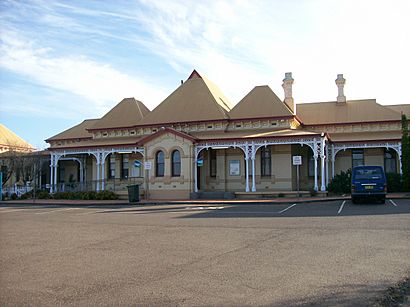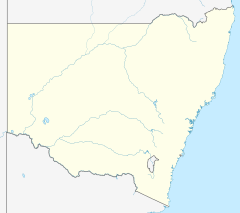Armidale railway station facts for kids
Quick facts for kids
Armidale
|
|||||||||||||
|---|---|---|---|---|---|---|---|---|---|---|---|---|---|

Station front in September 2007
|
|||||||||||||
| Location | 240 Brown Street, Armidale | ||||||||||||
| Coordinates | 30°30′55″S 151°39′06″E / 30.5152°S 151.6517°E | ||||||||||||
| Owned by | Transport Asset Holding Entity | ||||||||||||
| Operated by | NSW TrainLink | ||||||||||||
| Line(s) | Main Northern | ||||||||||||
| Distance | 578.87 km (359.69 mi) from Central | ||||||||||||
| Platforms | 1 | ||||||||||||
| Tracks | 3 | ||||||||||||
| Construction | |||||||||||||
| Structure type | Ground | ||||||||||||
| Disabled access | Yes | ||||||||||||
| Other information | |||||||||||||
| Station code | ARM | ||||||||||||
| History | |||||||||||||
| Opened | 3 February 1883 | ||||||||||||
| Services | |||||||||||||
|
|||||||||||||
|
|||||||||||||
| Official name | Armidale Railway Station & Stationmaster's residence | ||||||||||||
| Type | Complex / Group | ||||||||||||
| Criteria | a., b., c., d., e., g. | ||||||||||||
| Designated | 2 April 1999 | ||||||||||||
| Reference no. | 01074 | ||||||||||||
| Official name | Armidale Railway Station and yard group movable relics | ||||||||||||
| Type | Complex / Group | ||||||||||||
| Designated | 2 April 1999 | ||||||||||||
| Reference no. | 01075 | ||||||||||||
| Official name | Railway Turntable | ||||||||||||
| Type | Built | ||||||||||||
| Designated | 2 April 1999 | ||||||||||||
| Reference no. | 01233 | ||||||||||||
| Location | |||||||||||||
The Armidale railway station is a historic train station located at 240 Brown Street, Armidale, New South Wales, Australia. It was built between 1882 and 1883 by Edmund Lonsdale and Henry Sheldon Hoddard. The station officially opened on 3 February 1883. At that time, it was the end of the railway line, until the line was extended to Glen Innes in 1884.
This station is the final stop on the Main Northern line. The last regular passenger trains going north of Armidale stopped in November 1988. Freight trains continued for a while, but the line north of Armidale is now closed. The station is listed on the New South Wales State Heritage Register because of its important history and design.
Contents
History of Armidale Railway Station
Building the Main North Line
The Armidale railway station is part of the Main North line. This line once connected Sydney all the way to Wallangarra on the border with Queensland. It was originally the main train route between Sydney and Brisbane. However, trains had to change tracks at Wallangarra because the track widths were different. Today, the line north of Armidale is closed. The main route between Brisbane and Sydney now uses the North Coast line.
Armidale's Early Days
Armidale was first settled in the early 1830s. This happened after John Oxley explored the area and suggested it was good for farming. Soon, pioneers started small farms there. Armidale became a town in 1849. It was set up to be a market and administration centre for the farms. The town grew quickly after gold was found nearby in the 1850s.
Choosing the Railway Route
The Great Northern Railway started in 1857. But there was a lot of debate in the 1870s about where the line should go next. People argued if it should go through Armidale and Tenterfield or through Barraba and Inverell. On May 18, 1878, the Minister for Public Works, John Sutherland, announced that the route through Armidale was chosen.
Opening the Station
The railway line reached Armidale on February 3, 1883. It was an extension from Uralla. The line then continued to Glen Innes the next year. Edmund Lonsdale was given the job to build the station building, the Station Master's house, and other parts of the station in 1882. Lonsdale was a builder who later became a politician. The beautiful cast-iron details on the station building were made by Henry Sheldon Goddard in Uralla.
Station Changes Over Time
Over the years, the station added more features. In 1882, a place for train engines (a loco depot) was built. A coal stage was added in 1891. A new, larger turntable was installed in 1899 to turn engines around. The platform was made longer in 1907 and again in 1912. A signal box, which helps control train movements, was added in 1918.
The loco depot closed in 1984. However, Armidale remains an active railway station today. It still has daily passenger services.
Key Upgrades and Changes
- 1882: Buildings for engine crews, porters, and a gate house were built.
- 1886: Refreshment rooms were added for passengers.
- 1907 & 1912: The train platform was extended to make more space.
- 1913: An overbridge was opened, closing a busy street crossing.
- 1922: A subway was built, and some level crossings were closed for safety.
- 1926: A loading area for sheep was built.
- 1984: The engine depot at Armidale closed down.
Current Services at Armidale
Armidale station is served by NSW TrainLink's daily Northern Tablelands Xplorer train service. This train travels to and from Sydney.
The station also has coach (bus) services. There is a weekly NSW TrainLink coach service to Inverell (on Tuesdays). A daily NSW TrainLink coach service goes to Tenterfield.
| Platform | Line | Stopping pattern | Notes |
| 1 |
North West Region
|
services to Sydney Central |
|---|
What the Station Looks Like
The station buildings are in very good condition and still look much like they did when they were built.
Station Building (1883)
This is a large, important station building. It is made of brick and has a special section at each end. The main ticket office is in the middle. It has a raised roof and its own entrance. The entrance has verandahs on either side. These verandahs have fancy columns made of cast-iron with detailed patterns. The roof over the platform is also supported by cast-iron columns and brackets. The building has decorative brickwork. The roof is now made of corrugated iron, but it used to be slate. Some parts of the verandah have been enclosed.
This building is unique because the station master's office is on the street side. You get to it through the ticket office. The building also had two waiting rooms for ladies, one at each end.
Goods Shed (1883)
This is a large building used for storing and loading goods. It has two parts. The first part was built in 1883 from timber. It has a gabled roof made of corrugated iron that hangs over the sides. This overhang protects two loading areas. This part includes a storeroom and an office. The second part was added in 1965. It is made of brick and steel and provides a large, covered loading area. The crane that used to load goods has been removed.
Other Important Structures
- Station Platform: The platform was built in 1883. It has a brick front and sloped ends. The brick loading dock platform is also considered historically important.
- Barracks: This building, from around the 1880s, was where train drivers could rest. It is made of brick and timber and has a covered verandah. It might be the oldest surviving drivers' rest house.
- Former Per Way Offices and Sheds: This building is made of corrugated iron. It currently holds a collection of small rail vehicles called trikes.
- Turntable (1899): The 18.2-meter wide turntable is also listed separately on the New South Wales Heritage Register. It was used to turn train engines around.
- Other Items: The station sign, scales, station clock, and fences are also considered historically important.
Why Armidale Station is Heritage Listed
The Armidale railway station is very important to the history of New South Wales. It is especially known for its grand, 19th-century station building. This building shows off great design and beauty. It also reminds us how important Armidale was as a major regional town and a key railway spot. Today, it is the end of the northern train line.
The station building and other structures at Armidale show how quickly the railway system grew in the 1880s. This growth happened in the New England region and other parts of NSW. The station building is a wonderful example of railway architecture from the late 1800s. It still has many of its original details. The station building is still used today. It is a major public building and an important part of Armidale's town look.
Armidale railway station was added to the New South Wales State Heritage Register on April 2, 1999, for several reasons:
Historical Importance
The Armidale railway station is a clear link to the history of the Great Northern Railway (GNR). The GNR was a huge achievement in transport and engineering in NSW. It was the third main railway line in NSW, connecting Sydney to the Queensland border. This line linked towns and cities to each other and to Sydney. This had a big impact on the economy and social life of these towns and NSW. The station building and yard show how much the railway system expanded in the 1880s. They also show how important Armidale was as a major regional centre.
Connection to Important People
The Armidale railway station is linked to an important person from Armidale, Edmund Lonsdale. He built the station building. He later served as a NSW state politician for over 20 years.
Beautiful Design
The station building is very important for its beautiful design. Armidale is a large, first-class station building with many decorative details. The building stands out and has a strong presence in the town of Armidale.
Community Connection
The railway station is important to the local community. It played a big role in supporting Armidale as a centre for farming and trade. It was a place of much activity and employment. The railway station helps the local community feel connected to their past. It has been in continuous use since the 1880s.
Research Value
Armidale station has the potential to help us learn more about the history of New South Wales. It is a historic and typical example of a rural railway station building and area.
Example of Railway Design
The railway station area includes many typical railway structures. The station building itself is a good example of first-class railway architecture in NSW. Together, the station and its structures show common railway customs, activities, and designs from the 19th and early 20th centuries in NSW.


